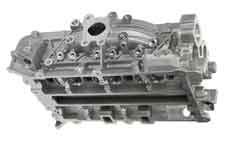Lotus Engineering has designed a cylinder head with an integrated exhaust manifold (IEM). The production-ready design, it says, can significantly reduce manufacturing costs, emissions and weight on most gasoline-engined passenger vehicles.
The cylinder head, for a small 3-cylinder engine, is the latest of a number of IEM designs developed by Lotus Engineering as part of its consultancy business.
Following its development programmes, the UK automotive engineering consultancy estimates that for a typical DOHC 16-valve 1.6 cylinder gasoline engine, an IEM has potential to cut up to 5% of the total build cost, reduce catalyst light-off time by up to 20% (approx five seconds), reduce powertrain mass by up to 5 kg as well as improve engine durability.
By integrating the manifold tracts into the cylinder head, the parts count is reduced significantly, saving costs throughout the development cycle and supply chain, from inventory and assembly to aftermarket supply.
Emissions reduction is achieved by locating the catalyst very close to the cylinder head which reduces exhaust gas heat loss upstream thereby cutting the catalyst light-off time. The reduction in overall engine heat loss is achieved through minimising the surface area of the manifold by keeping the exhaust tracts within the head. Through intelligent cooling jacket design, heat is retained in the engine rather than lost to the engine bay, accelerating engine warm-up so it more quickly reaches optimal efficiency. This also benefits the HVAC performance, reducing windscreen demist and passenger cabin warm-up periods.

Engine durability is improved as a result of the reduction of thermal stresses in the engine. With the exhaust manifold integrated into the cylinder head, the stresses usually associated at the interface of different materials, for example where the cast iron exhaust and the aluminium cylinder head meet in a conventional design, are eliminated. Also, due to the design of the cooling jacket and coolant routing, the coolant heats up far quicker, resulting in a more uniform heating of the entire engine, again contributing to reduced stresses in the engine.
Integrating the exhaust manifold reduces the mass of the engine, further increasing overall vehicle efficiency. It also results in a more compact overall engine and reduced packaging demands for the engine under the hood, delivering a range of subsequent benefits for vehicle packaging.
Lotus Engineering has already proved the concept to production readiness in several demonstrator programmes with a variety of cylinder head configurations.




Poll: Should the UK’s railways be renationalised?
I think that a network inclusive of the vehicles on it would make sense. However it remains to be seen if there is any plan for it to be for the...